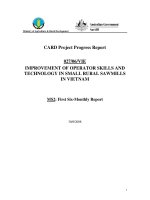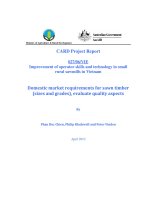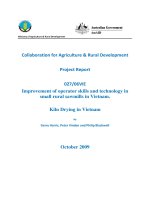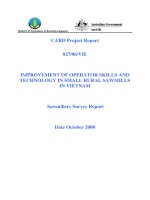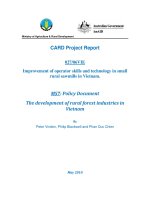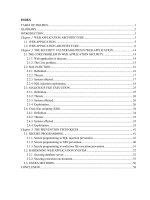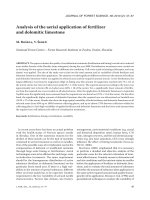Application pillar dam and movable caisson dam technology in building barrier construction to prevent sea water rising and improving flood relief at estuary rivers.
Bạn đang xem bản rút gọn của tài liệu. Xem và tải ngay bản đầy đủ của tài liệu tại đây (1.3 MB, 10 trang )
1
Application pillar dam and movable caisson dam technology in
building barrier construction to prevent sea water rising
and improving flood relief at estuary rivers.
Pro.PhD Truong Dinh Duz; PhD Tran Dinh Hoa; MSc Thai Quoc Hien; MSc Tran Van Thai
Viet nam Academy for Water resource Research.
Add: 171 Tay son – Dong Da – Ha Noi
Abstract:
Global climate change is causing terrible disasters such as droughts, floods and sea levels
rising. To overcome this disaster is much work to do, but first of all, barrier constructions are
done to prevent the sea water rising and also keeping fresh water for the national economy
development.
Due to the characteristics of most estuaries is deep, wide and soft soil therefore traditional
technology would be difficult to implement or difficulty in construction. Application pillar dam
and movable caisson dam technology in building barrier construction at estuary will overcome
the difficulties mentioned above, offer high performance in building, Operations, Administration
and Maintenance.
I. Preface
From the ancient times to the present,
most of river barrier works have been
constructed by traditional methods. The
works in reinforcement concrete bulk form
with characteristics as shown: bed slab from
1m to 1,5m thick, piers are placed on the
slab, the between of piers is valve gates, pile
system or non pile is placed under bed slab
depending on foundation geology
There are 3 methods for traditional works. The first is applied for works which
constructed on bank: Excavating foundation
hole, Construction of sluice on bank,
Diversion through original river bed,
Excavating canal for connecting sluice
upstream & downstream and original river
after sluice constructed, then earthfill dam is
embanked for closure of old river. This
method is widespread in Vietnam and it is
applied for works constructed on bench part
of river.
gate
Pier
Bottom
pile foundation
upstream apron
Stilling apron
Fig 1: Cross section of traditional works
River
Upstream
Downstream
soil Dam
Figure 2: Traditional sluice on bank
2
The second is applied for sluices constructed on river bed: Excavating of diversion canal
on right/left bank, Embankment of downstream & upstream cofferdam for closure construction
site. Construction of sluice in dry foundation hole. After sluice constructed, Cofferdam must be
broken out for flow running through sluice and closing diversion canal. This kind of method is
done on straight parts of river.
The third is applied for construction
of a part of sluice in cofferdam:
Embankment of cofferdam for enclosing a
part of river, Construction of a part of
sluice in cofferdam, Diversion through a
part of remain river of original river. After
completing sluice construction, cofferdam
must be broken out, Diversion through
constructed part of sluice, Embankment of
cofferdam for construction of the remainder part of sluice. This method is used for construction
of works on wide part of river.
The traditional method has advantage of being easy control in construction, skill in design
and construction. However, diversion
construction is complex if these methods
are applied to works on Mekong delta or
large river regions, and the weakness
which are very difficult to over come has
occurred at living resident zones as : Big
quantity, a lot of construction land area
occupied, Environment effected, some
sites are difficult for construction and high cost. The methods are difficult to apply to the regions
of cropping pattern transition.
II. Movable caisson dam technology
The idea of technology was given from 1992 - 1994. In the year of 2003, this technology
was continued to study in the ministry level subject “Design study and production of movable
caisson dam for economic structure transition on the Mekong delta “. In 2004 year, the
permission of experiment production with this technology was given at ministry level DAĐL-
2004/06 “Completing design production, construction and operation & maintenance of movable
caisson dam which applied for construction of rive barrier works at coastal/tide regions”. This
technology was applied to construct two dams in Phuoc Long – Bac Lieu (2004), Thong Luu –
Bac Lieu (2005) . In 2005 year, the technology was applied for technical design of 16 sluices on
the rice-growing area of Ninh Quới and for setting the feasibility study of 22 sluices of salty-
sweet boundary division project at Giá Rai of Bạc Liêu province. In 2006 the design and
Upstream
Barrier
Downstream
CofferDam
Diversion canal
Figure 3: Construction of traditional sluice on river
bed
Barrier
CofferDam
Upstream
Downstream
Figure 4: Diversion sluice through river
3
construction for 7 sluices of Omon-XaNo project was applied this technology by the Ministry of
Agriculture and Rural Development (MARD) and two sluices named Minh Ha &Rach Lum of
Tran Van district, Ca Mau province were also successful in the year of 2007.
The movable caisson dam technology was not only evaluated at the Vifotec award in
2006 and the invention exclusive right degree given in 2007, but also at the award of excellent
technology among 5 awards on August 2007 given by the decision of ACECC – Asian Civil
Engineering Coordinating Council.
II.1 Technological principle and structure of movable caisson dam
a. Principle:
Slump stabilization: Application of optimal structure with light slab beam for bed stress
smaller than allowable stress of weak bed, and the bed treatment is not necessary accordingly.
Slide, overturning stabilize: Using bed earth friction with bed of works and sluice side
earthfill with side wall.
Permeable stabilization: Following the horizontal border principle under the bed of works.
Erosion stabilization: Enlargement of sluice span for speed after sluice smaller than
allowable erosion speed of weak original
earth, and so, the simple consolidation is
only necessary.
b. Structure of works:
Form 1 (Hermetic float box):
Bed and pillar in box form with side
slab structure and optimal bearing frame.
Material for production of movable caisson
dam is normal one such as reinforcement
concrete, steel, composite. Movable caisson
dam bed box is divided a lot of gallery spans. Each works can be included 1 barge with valve
spacing from 4 to 30m or many barges connected each other by watertight structure depending on
the width of river.
Form 2 (side slab box): Bed box and pillar with side slab unit structure, both of upstream
and downstream of sluice are location for installation of valve or slot, sluice body and slot at two
heads, these made a box with open on face and water tight around faces, so that the sluice can be
floated on the water surface and movable to construction site.
Figure 5: Cross section of movable caisson dam
4
The gates using for this works can be Clape, segment, self acting, rubber, vertical lift gates…
c. Construction solutions:
* Caisson dam manufacture:
- This dam is manufactured in factory
or precast hole, or on earth mound where
land clearance is not necessary.
- Installation of valve gate and
operation equipment.
- Diversion water into precsat hole
to float dam to construction site.
* Erection work:
- Excavation of foundation hole:
- Chief cost price, expenditure for the dam is less 40% than traditional works in the same
condition. Investment level for traditional method is around 800 million VND per 1m sluice
while only 250 million VND per 1 m sluice for caisson dam technology. Taking Phuoc Long dam
in Bac Lieu province as one example on its price of 8 billions VND for traditional method and
only 2.3 billions for caisson dam technology.
- The method has both of science and economic significances on caisson dam’s movable
ability in case of changing construction site by crop production transition demand, and it can be
reused works structure, even expenditure is not necessary for breaking out work .
- Backward dam can be replaced by temporary one but it will be waste and environment
pollution, during only 10 years of dam management, the expense for temporary dam is the same
expenditure as for construction of one movable caisson dam.
b. Technical output:
- Movable caisson dam technology has opened one more new direction of river barrier
technology and promoted new technology development in construction of river barrier works.
- Using bearing ability of original bed for works construction without weak foundation
treatment costly.
- Optimizing its structure, saving materials, Thông Lưu dam as one example. It was
constructed with traditional method with around of 1500m³ reinforcement concrete, but with
movable caisson dam technology, the Thong Luu dam was completed with the amount of 180m³
reinforcement concrete
- Quick construction, reducing land area occupied by project site.
- Stable project and easy in O & M work
- Movable caisson dam can be manufactured and erected according to technology nature.
c. Social output:
Figure 6: Phước Long dam for salty protection
5
- This dam is constructed and
erected on river, so that it is not
necessary to move houses, make
compensation…If traditional method
was applied in dam construction, the
above-mentioned work must be done.
- The new technology should
meet tide zone economic development
requirement for improving living
standard and contributing on social
stable at coastal regions.
-The new technology brings higher output in construction at underdevelopment
transportation zones material transportation is very difficult at zones with complex natural
topographic conditions as Ca Mau peninsula where is remote area.
- Movable characteristic of caisson dam meets open planning, future economic
development for contributing the national agricultural modernization.
- Environmental pollution is not occurred at zones where broken out temporary dam.
Natural environmental landscape is not changed by using movable caisson dam technology
(construction diversion and plan are not need to be done…).
- Environmental protection and flood drainage capability at caisson dam site are better
than traditional and temporary dam sites by spacing open.
- The types of present works and difficulties at Ca Mau peninsula can be solved by
movable caisson dam technology but not by others.
III. Pillar dam
III.1. Definition of pillar dam
Pillar dam is type of works on river, its duty is water source regulation. Pillar dam is
constructed on river bed. The water drainage and river bed are about the same width, bearing by
pillar laid on pile system, beam supports valve which placed on two pillars, permeable protection
by grooved pile under valve supported beam erosion protection by rock cover.
Water pressure by the difference between upstream and downstream which is received by
valve gate and together with loading capacity on bridge, all, transmitted into pillar, then
continued down to foundation pile system. Such type of works for water barriering and regulation
is called pillar dam.
III.2.Design principle of pillar dam
1. Works stable by pile system fixed into earth bed of river. It can be used reinforcement
concrete, pipe, or filling piles depending on field conditions. Pillar dam is bearing big vertical
loading capacity, because of in pillar dam there are a lot of piles for bearing cross loading
Fig. construction of sluices in foundation hole Cà Mau


